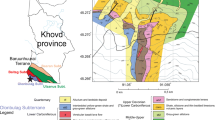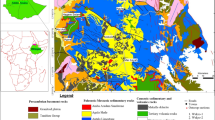Abstract
In Mawat area, the Late Maastrichtian Aqra Formation (or lens) is located in the upper part of the Tanjero Formation (Lower–Middle Maastrichtian) and overlain by Red Bed Series (Paleocene–Eocene). This lens consists of about 10–100 m of massive biogenic and well-bedded detrital limestone with rich fossil content such as rudists, large forams (luftusia, omphalocyclus, and orbitoids) gastropods, pelecypods, and echinoderms. The present study discusses the geology of an association of rudists and red clastic facies in the upper part of the Aqra Formation. The tectonic and paleogeographic importance of the association are clarified and correlated with similar occurrence in Turkey and Iran. Sedimentologic and paleontologic evidence proved that all the rudists were preserved in their life position which shows that their orientations are in right side up and evidence of reworking or transporting was not found. The occurrence of these opportunistic rudists, in the red clastics, has one to three very important implications. The first is that it is possible that the red clastics belong to and occur in the Cretaceous (Maastrichtian). This occurrence is the first to prove paleontologically that red clastics are deposited during the Late Cretaceous in northern Iraq. This finding has tectonic implication as red clastics prove that the source area was active and soil development started on the recently uplifted Zagros orogenic belt. The second is that some opportunistic rudists were crossed the Tertiary/Cretaceous boundary and survived at the Early Paleocene. Since evidence from the over world put the age range of the rudists between the Late Jurassic and Late Cretaceous, this possibility is discounted by the present authors. Between the two possibilities, the authors prefer the first one. The third is that the extinction of rudists was due to prevalence of turbid red clatics in the northern Iraq.











Similar content being viewed by others
References
Al-Barzinjy STM (2005) Stratigraphy and basin analysis of Red Bed Series from northeastern Iraq-Kurdistan Region. Unpublished Ph. D. thesis, University of Sulaimani University, 159p
Al-Mehaidi HM (1975) Tertiary Nappe in Mawat Range, N.E Iraq. Jour Geol Soc Iraq 8:31–44
Buday T (1980) Regional geology of Iraq: Vol. I., Stratigraphy: I. I. M Kassab and S.Z. Jassim (Eds) D. G. Geol. Surv. Min. Invest. Pub. 445p.
Buday T and Jassim S Z (1987) The regional geology of Iraq: tectonism, magmatism and metamorphism. I. I. N., Kassab and M. J. Abbas (Eds), Baghdad, 352 p.
Colin J P, Vaziri-Moghaddam H Safari A and Shariari Grai S (2012) Presence of Frambocythere Colin, 1980, (limnic ostracode) in the Maastrichtian of the Zagros Mountains, Iran: a newly recognized link between southern Europe and the Far East. Carnets de Géologie (Notebooks on Geology)-Letter 02 (CG2012 -L02).
Flugel E (2004) Microfacies analysis of carbonate rocks. Springer Verlag, Berline, 976 p
Jassim SZ, Goff JC (2006) Geology of Iraq. Published by Dolin, Prague and Moravian Museun, 431p
Johnson CC (2002) The rise and fall of rudist reefs. Am Sci 90:148–153
Karim KH (2004) Basin analysis of Tanjero Formation in Sulaimanyia area, NE-Iraq, Ph.D. thesis, University of Sulaimaniyai, 135 p.
Karim KH (2006) Some sedimentary and structural evidences of a possible graben in Mawat–Chuarta area, NE Iraq. Iraqi Jour. Earth Sci 5:9–18
Karim KH, Surdashy AM (2005) Tectonic and depositional history of Upper Cretaceous Tanjero Formation in Sulaimaniya area NE-Iraq. JZS 8:11–23
Karim KH, Surdashy AM (2006) Sequence stratigraphy of Upper Cretaceous Tanjero Formation in Sulaimaniya area, NE-Iraq. KAJ 4:19–43
Levinton JS (1970) The paleoecological significance of opportunistic species. Lethaia 3:69–78
Ma,ala KA (2008) Geological map of the Sulaimaniyah Quadrangle, sheet N1-38-3, scale 1:20000. GEOSERV, Baghdad, Iraq
Meriç E, Oktay FY, Özer S (1985) Besni Formasyonu’nun Alidamı (Kahta, Adıyaman) kuzeybatısındaki stratigrafik gelişimi ile ilgili yeni gözlemler [New observations about the stratigraphic development of the Besni Formation in the northwest of Alidamı (Kahta-Adıyaman), Southeastern Anatolia). Jeoloji Mühendisliği 25:51–54
Nannofossils Consultancy (2012) Preliminary study of calcareous nannofossils from samples BR, TSM, MBK, RRS–Iraq. Unpublished report, Nannofossils Consultancy Ltd Report, London, Report No. 12/1809, 15p
Numan N M S (1997) A plate tectonic scenario for the Phanerozoic usccession in Iraq. Journal of Geological Society of Iraq 30:85–110
Özer S (2010) Dictyoptychus Douvillé: taxonomic revision, phylogeny and biogeography. Turkish Journal of Earth Sciences (Turkish J Earth Sci) 19:583–612
Özer S (1986) Faune de Rudistes maestrichtienne de l’ environs de Kahta-Adıyaman (Anatolie Sud-Est). Mineral Research and Exploration Institute (MTA) of Turkey Bulletin 107:101–105
Özer S, Karim KH, Sadiq DM (2013) First determination of rudists (bivalvia) fromNE Iraq: systematic palaeontology and palaeobiogeography. Bulletin of MTA (Bulletin of the Mineral Research and Exploration of Turkey) 147:31–55
Sadiq DM (2010) Facies analysis of Aqra Formation in Chwarta-Mawat Area from Kurdistan Region,NE-Iraq. Unpublished MSc thesis, College of Science, University of Sulaimani, p 105
Skelton PW (1991) Morphogenetic versus environmental cues for adaptive radiations. In: Schmidt-Kittler N, Vogel K (eds) Constructional Morphology and Evolution. Springer, Berlin, pp 375–386
Steuber T, Loser H (2000) Species richness and abundance pattern of Tethyan Cretaceous rudists (Mollusca: Hipputitacea) in the Central-Eastern Mediterranean and Middle East, analyzed from paleontological data base. Paleogeography, paleoclimatology. Paleoecolog 162:75–104
Waage KM (1968) The type Fox Hills Formation, Cretaceous (Maastrichtian), South Dakota. Part 1. Stratigraphy and Paleoenvironments. Peabody Mus. Bull. Yale University, Bull. 27: 171.
Author information
Authors and Affiliations
Corresponding author
Rights and permissions
About this article
Cite this article
Karim, K.h., Khanaqa, P.A. Association of rudists and red clastic facies in the upper part of Aqra Formation, Mawat area, Kurdistan Region, NE Iraq. Arab J Geosci 8, 2751–2759 (2015). https://doi.org/10.1007/s12517-014-1376-0
Received:
Accepted:
Published:
Issue Date:
DOI: https://doi.org/10.1007/s12517-014-1376-0




